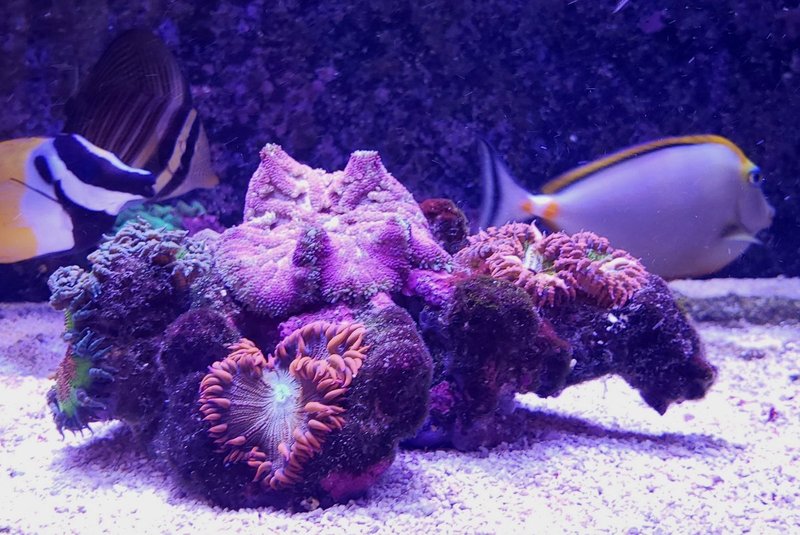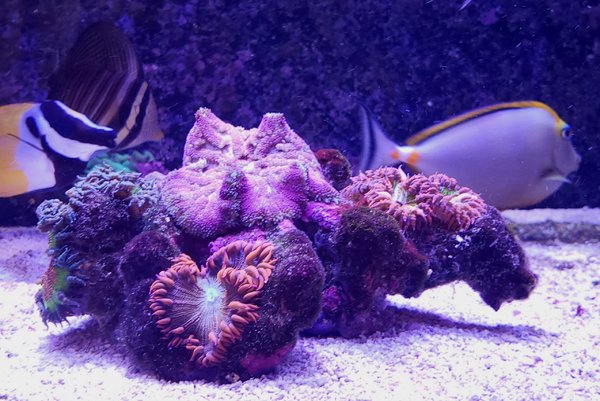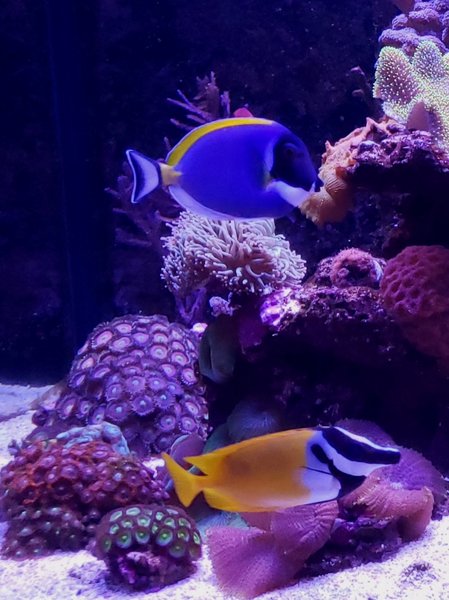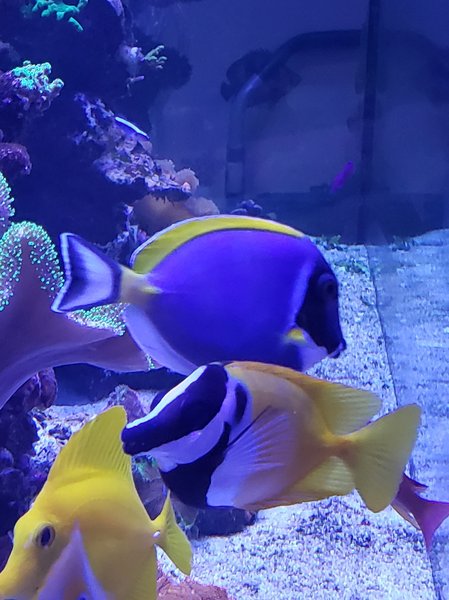
Jon Lazar
WAMAS Family Member-
Posts
3,250 -
Joined
-
Last visited
Content Type
Profiles
Forums
Gallery
Events
Store
Everything posted by Jon Lazar
-
Yes. It would be easiest to do this with an aquarium controller and an optical sensor. I'm only familiar with the Neptune Apex. You could use either a breakout box with a float switch, or the Flow Monitoring Module with an optical sensor. A high level would activate the switch/sensor, switch off the pump, and sound the alarm or email you. You'd program it so once it turns off the pump, it stays off. Otherwise the pump will repeatedly cycle off and on. IMO you're much, much better off with an overflow design that can't flood, like a 3-pipe Bean Animal. Maybe your tank configuration won't support that, though. Can't you drill a second hole for an emergency overflow?
-
The Apex classic is plenty powerful. I use one Apex classic to run all aspects of my 350 and my frag tank. You can pick up a complete used Apex classic, DC8, temp probe, and display for around $300.
-
Sorry, but that's so JV ;). Just move or replace the HVAC!
-
I placed several on their own rock maybe a year ago and they haven't wandered. I picked a rock with deep crevices thinking they might be more comfortable that way and not willing to walk across a desert of sand.
-
Yep. I dosed too much magnesium sulfate last fall and ended up with very high sulfur levels, which killed nearly all my acros. The only way I figured it out was a Triton test. FWIW, their recommendation was to do a lot of water changes. That might be a good idea for you to start while you're waiting for your test results. Good luck!
-
You can place them side by side, along the width of your stand. IME the best way is to install adjustable feet. If your stand is built properly, you don't need the whole length of the stand resting on the ground. It's the same concept as a framing header above a sliding glass door.
-
How about a composite or rubber furniture shim:
-
Do you have a reef and corals worth saving? If so, you would do better with biological controls like peppermint shrimp, filefish, and nudis. If your tank is ready for a reboot, then go ahead and remove the lifestock and replace all the rock. You'll get rid of most of the aiptasia quickly, but there are sure to be remnants somewhere. On your corals, in your overflow or sump, inside your plumbing, etc. They'll return and you'll still need biological controls in the long run to keep them from exploding. FWIW, I always include an aiptasia-eater when making a livestock list for a new tank.
-
Ok, I think I understand. You need a four sided overflow (bottom, left, right, rear) that you can silicone to the back of your glass tank. That's why the typical pre-manufactured 5-sided overflow box won't work. And you want the bottom of the overflow to be drilled with three holes for your plumbing.
-
I'd go with the seagrass lagoon / planted tank.
-
The coral looks stabilized in this picture. The tissue is inflated and there's no white margin from recent tissue loss. I would leave it alone except to feed it small amount of meaty food daily. Don't give it large pieces that it can't digest. Nothing larger than a mysid shrimp, although you can feed more than one mysid. Make sure the fungia is upstream from the other corals. Favia can put out long sweeper tentacles at night and sting the heck out of other corals. Watch for algae growth that will inhibit recovery. Good luck! It's very satisfying to restore a coral from the brink of death.
-
I've had this happen when there's been a puncture in the bag and the salt turns hard from moist air getting into the salt. It seems that also turns the bag yellow.
-
Sick/dying fish...is there anything I can do???
Jon Lazar replied to Still_human's topic in General Discussion
Other symptoms to look for are swimming directly into the output of your powerheads, staying in the shade all the time to avoid light, flashing against the rocks or sand, clamped fins, faded colors, and rapid heavy breathing. These symptoms may have started around the time the fish stopped eating. You may also see some of these symptoms in your other fish. -
Sick/dying fish...is there anything I can do???
Jon Lazar replied to Still_human's topic in General Discussion
My standard advice here it that when a fish suddenly starts laying on it's side like you describe, it means the fish is having trouble breathing. Remove the fish to a treatment tank. Take immediate steps to increase the oxygenation of the water. Increase circulation and aeration. An airstone under a powerhead creates massive air bubbles in your tank. That's a good thing for a suffocating fish. Set a slightly lower tank temperature. This increases the oxygen saturation, while decreasing the fish's need for oxygen. Then I would begin treating the fish with the assumption of any of the common gill parasites (velvet/brook/ich). I would start with a 5 minute freshwater or 45 minute formalin dip, and start therapeutic treatment with copper. I've been using Copper Power with good results. If you can put the fish into hyposalinity, do it. It won't eradicate velvet, but it will make the fish more comfortable. There's a lot of velvet out there that doesn't present like the "powdered sugar" pictures you see. IME, it's extremely subtle and almost impossible to detect with the naked eye. -
The problem is carbon fines. You can add a grounding probe if you like and maybe it will help, but your priority should be the carbon.
-
Or, realize that this is a catastrophe waiting to happen and flood your house. Therefore, to be safe, you MUST upgrade to a larger/better/newer tank.
-
That's what I would do too. Try to figure out what's leaking. Once you isolate the leak, figure out a permanent fix.
-
Allen's Unexpected Tank -- 55 Gallon
Jon Lazar replied to AHarp's topic in Dedicated Tank (Build) Forum
Looks like a leather/toadstool coral (sarcophyton) I'd guess this is some sort of sponge. Put it somewhere in medium or low light and see what happens. If it's photosynthetic, it should grow. If it's not photosynthetic, algae may start growing on it and you'll have to move it into the shade. These are yellow polyps. They'll do well in most any light. This looks like a photosynthetic gorgonian. It should have lots of little polyps along its branches when it's happy. -
Looking for help with removing silicone & reseal.
Jon Lazar replied to achansek's topic in Do It Yourself
Here's what I used. A combination of a paring knife with a flexible blade, and fine, strong wire. Use the knife to get started, and use the wire as a garrote. -
IME a new fish suddenly laying on it's side like you describe means the fish is having trouble breathing. I would take immediate steps to increase the oxygenation of the water. Increase circulation and aeration. An airstone under a powerhead creates massive air bubbles in your tank. That's a good thing for a suffocating fish. Set a slightly lower tank temperature. This increases the oxygen saturation, while decreasing the fish's need for oxygen. Then I would begin treating the fish with the assumption of velvet. I would start with a 5 minute freshwater or 45 minute formalin dip, and start therapeutic treatment with copper. I've been using Copper Power with good results. If you can put the fish into hyposalinity, do it. It won't eradicate velvet, but it will make the fish more comfortable. As others have said, keep a close eye on ammonia. I've bought a lot of fish over the last two years, from several very common online stores that we all use. There's a lot of velvet out there that doesn't present like the "powdered sugar" pictures you see. IME, it's extremely subtle and almost impossible to detect with the naked eye. Good luck!
-
Are you certain that the resin is color-changing? Not all resins do that.
-
Most stock laundry sinks I've seen are too short, and give me a backache from bending over them while scrubbing pumps or whatever. My sink is mounted in a cabinet, and I raised the cabinet maybe a foot higher than stock. My back loves it. I built my water station from two 55 gallon barrels that were originally used for soda syrup. They were $5 each. Someone from WAMAS picked up a bunch of them and passed the savings on to club members. I think they're also available through Craigslist. I absolutely love having a tank controller. Mostly because if something measurable goes wrong, I receive email/text notification and can sound an alarm. Ever forget to turn your heater/ATO/whatever on after doing a water change? I have a switch that turns all the right things off for a water change, then all back on when I'm done. The Apex classics are fine for most users, and you don't need the latest version (Apex 2018). I still use an Aquacontroller II for one of my tanks. I bought it used in 1998. You can buy a late model used Apex setup with most everything you need for $300. You would need the controller brain, an energy bar outlet trip, and a temperature probe. Later you might add an Avast breakout box. You'll be so glad you did. Planning doesn't guarantee success, but not planning guarantees failure.






.thumb.jpg.37b80484d4d30c3553f276a8626d5d9f.jpg)